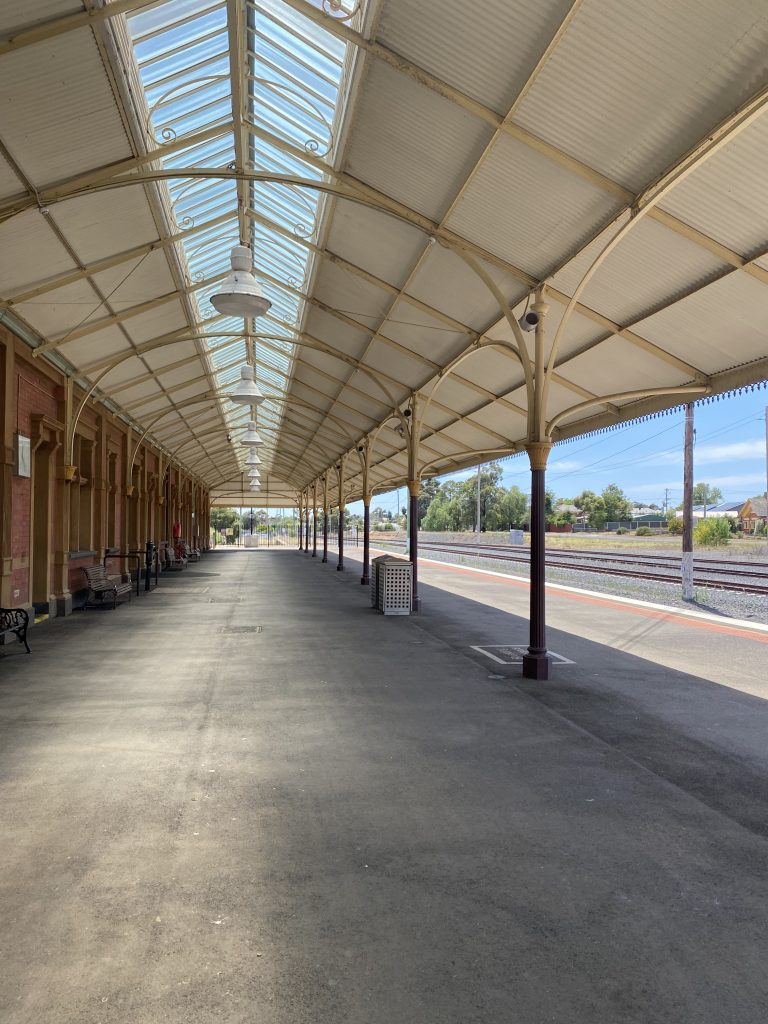
Maryborough Railway Station – its as impressive as Mark Twain says!
An opportunity to hear a relative’s daughter in the Victorian Goldfield town of Maryborough was too good to pass up. It’s about 45 minutes from Ballarat and a couple hours from Melbourne, however, for us it was a six and a half hour drive, which with a couple of stops made it about an hour longer. Easy to do in a day from Adelaide.
We set off early on the Friday, taking the well worn path through Tailem Bend, stopping for a late brekkie in Keith at Henry and Rose. It’s been a go to for us in our recent trips. The coffee is always good, the service is friendly, and it has a good menu whether for brekkie or lunch.
I’ve lost count of the number of trips we have done on this road. Tailem Bend is about 70 minutes from Adelaide, and I always think it’s not until you drive past it you are actually on a road trip.

The recent addition of a world class motor sport park aptly named The Bend has increased activity in the region.
The towns on the drive are all ones we generally zip through. In the past, I have stopped at Cook Plains, but these days, it’s off the main road, so, these days, it’s a window view. Even though the towns whizz by, you can’t but love some of the town names, such as Coomandook and KiKi. We’ve occasionally stopped for a coffee and to ‘powder our nose’ in Coonalpyn. Like many of the towns along the road, it has a silo for the grain trains to stop at.
Once past Keith, it’s on through Bordertown across the border and into Victoria. We have often stopped in the nearby town of Mundulla if we’ve left late and need an overnight stay.
- Mumdulla – pictures taken on a previous trip
We made another stop at the quintessential Australian town of Dimboola. We couldn’t get over how much it had changed since our last visit 3 or so years earlier. On our previous visit, the town was all but a ghost town. Today it’s buzzing with lots of new shops. We revisited the Dimboola Imaginarium, which was being renovated when we last visited. The Forbidden Forest looks a great spot for kids and The Dimboola Store is great for coffee.
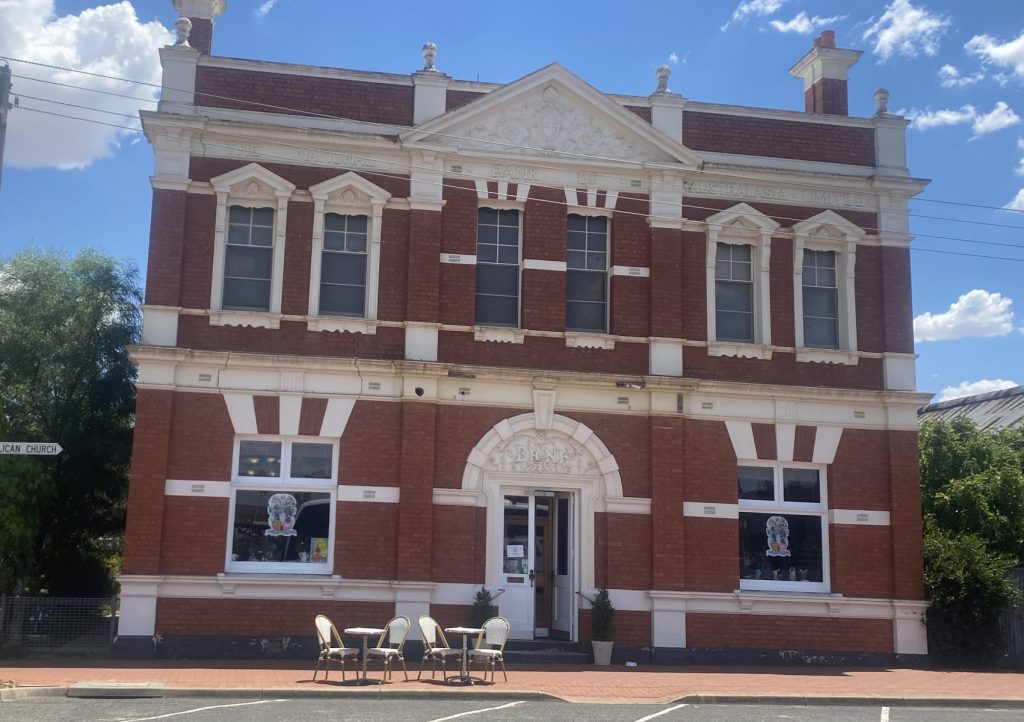
Dimboola Imaginerium
From there, it was back on the road, through Horsham and Stawell, all places we were familiar with, before turning off to Maryborough. We weren’t familiar with this road, but the countryside is pretty typical of the region—paddocks with a few sheep and not much else. The dams were all pretty dry, which was no surprise given that it’s been a hot, dry summer. The final part of the drive took us through the Pyrenees wine region and Avoca before arriving in Maryborough.
As I mentioned, our visit coincided with seeing my cousin’s daughter and band play. They were the post race entertainment at the Maryborough Harness Club.

We arrived to watch the last couple of races. The trots, as we used to call them, had always been a fun night for us as kids. I can’t recall the last time I’d been, so to catch a race or two before the band played bought back some fond memories.
Dinner was pretty standard country fare. Schnitzels a number of different ways. My Mexican chicken schnitzel was about the size of a chicken! A hearty and perhaps not so healthy meal. The wines were from Blue Pyrenees, which, by chance, we were scheduled to visit the next day.
It was a fun night followed by a family catch up and chat with the other band members.
Saturday morning was a chance to drive around Marlborough. The Train Station is a landmark as Mark Twain remarked on his 1895 visit. There are many stories about the station including, an urban myth that it was to be built in Maryborough, Queensland, but mistakenly built in Maryborough, Victoria.

The original station was built in 1874 and was considered too small. The new grandiose station was built around the existing station and opened in 1891. Its carved wooden ticket boxes, the grand hall and the dining hall, now a contemporary cafe, are all elaborate and certainly way beyond what you’d expect in a country town. No wonder Mark Twain was so taken by it.
Over the weekend, we had a chance to wander around the town and take in the architecture. It was very much typical of country towns in the goldfields. The public buildings are elaborate, as is much of the housing, although today they are indispersed with modern buildings and houses.



Our visit also provided an opportunity to visit some of the wineries in the Pyrenees region. The Pyrenees region sits at the foot of the Pyrenees Mountain Ranges. As a result, the countryside offers delightful views across rolling hills. I’d had a few wines from the region over the years but hadn’t visited before. We visited Blue Pyrenees and Summerfields on Saturday and Taltarni and Dahlwhinnie on Sunday.
We pretty much had the wineries to ourselves. We did a full range of tastings at Blue Pyrenees, although many of the wines we were offered had also been available the previous night at the trots. They were easy drinking with the Richardson unsurprisingly being our favourite. Our second winery was Summerfields, where we had fabulous-fired pizza in a delightful restaurant. Perfect for a hot summer night.
The Sunday offered more serious tastings at Taltarni, an old favourite. Our final winery was at perhaps the region’s most prestigious winery, Dalwhinnie.
- Taltarni Winery

Current release from Taltarni website
Taltarni had been a sentimental favourite since our second child was born. Being a girl, we celebrated with pink sparkling wine, of which the Taltani Tache was our favourite at the time.
We progressed quickly through the whites and onto the reds. The cellar staff were chatty and there was also a country band playing. Nice music in a delightful setting. As with most wineries, there were the obligatory wine dogs; one was fascinated by the shadows cast by the silver guitar of one of the band members, and the other just wandered around as if it owned the place.
From there, it was a short drive up the road to Dalwhinnie. But for it being a 2 minute drive further along the road, we wouldn’t have visited, which would have been a grave error. As I mentioned above, Dalwhinnie is perhaps the region’s pick winery. I already had a bottle of their Moonambel Shiraz in my cellar but hadn’t tried it. We had the cellar door to ourselves. The chatty cellar manager walked us through the wines. Again, quickly through the whites before trying the reds.
As I have become more interested in wine, I have made a considerable effort to understand what I was drinking and tasting. The Dalwhinnie Chardonnay was not what I was used to: delightful and flinty and not at all the buttery style that I was used to. On reflection, I think I sold it and the chardonnay at Taltarni short.
The Dalwninnie Reds were excellent. Although not the top of the range, the Pinnacle was our favourite, and the Three Valleys Pinot Noir, comprising fruit from the three pinot noir growing valleys in Tasmania, only whet our appetite for an upcoming visit to Tasmania.
Dalwhinnie Winery is perched atop a hill overlooking the winery and hills. It’s a winery not to be missed.

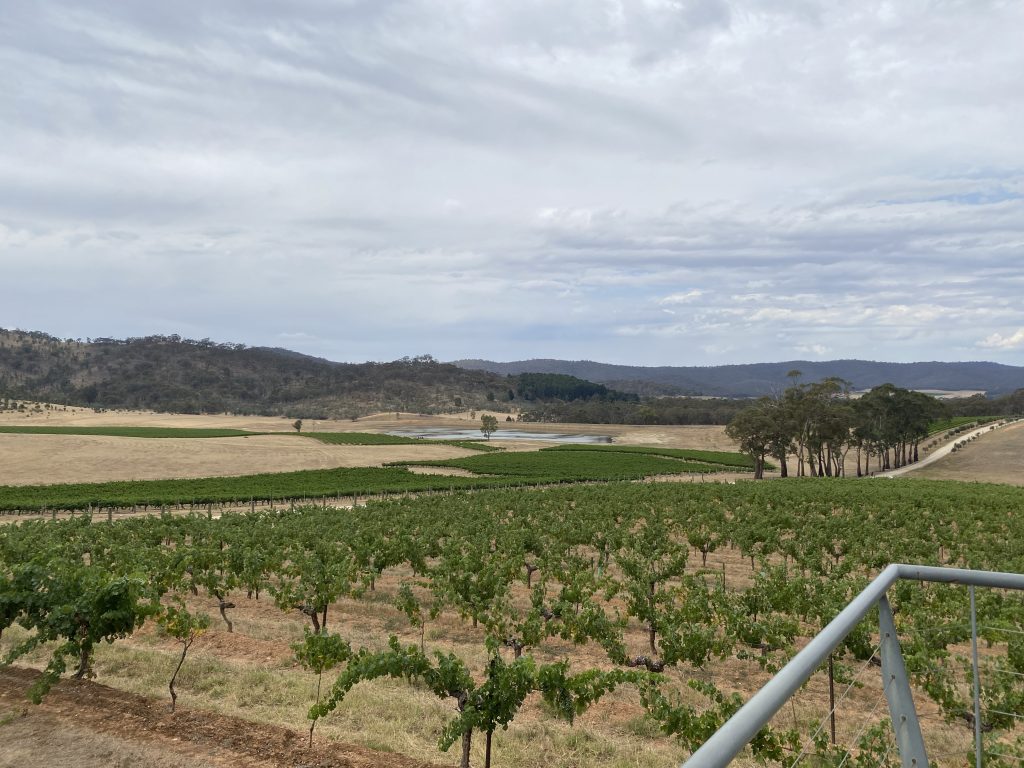
Dalwhinnie Wine Estate
Relieved of a not insignificant amount of cash, our winery visits were done; it was back to my cousins to prepare for a family gathering, a decent sleep and then the drive home.
These are the type pf trips I am coming to love. Visits to delightful parts of Australia. Towns like Maryborough are just so typicalof country regional Australia. They have their challenges but they offer so much to locals and visitors alike
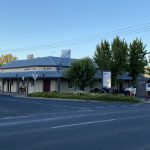
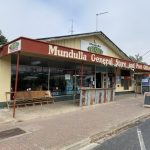
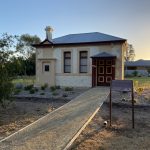






You packed a lot in! Sounds like a fun visit 😊
I think it sounds like we did a lot. but it didn’t feel rushed.
It’s a great part of Australia.